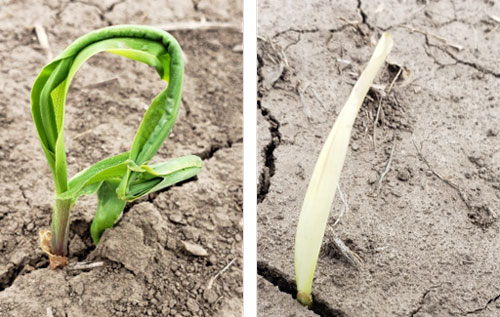Farmers have had to pause their preparation for spring planting due to the recent cold and snowy weather across much of Kansas. The recent drops in temperature have prompted concerns about the effectiveness of burndown herbicide applications made during cold weather. Will herbicide applications made in recent days be effective? Here are some factors that could influence the outcome on your farm.
Type of herbicide. Glyphosate and 2,4-D are two common components of burndown herbicide applications. They are both systemic, phloem mobile herbicides, meaning they have to move through the plant with the sugars made through photosynthesis. Data suggest that glyphosate translocation reaches its peak about 4 days after application. This means anything that slows down photosynthesis within 4 days of application is likely to reduce the effectiveness of the herbicide.
Other herbicides, like paraquat (Gramoxone, others) are contact herbicides, meaning they do not move through the plant. There is a theory that paraquat may be less effected by cold temperatures because it does not have to be translocated throughout the plant to be effective. However, the plant still needs to be actively growing for maximum herbicide effectiveness.
Weed characteristics. There is some variation in plant response to temperatures, but in general, weeds grow best with temperatures greater than 60°F. Even a cool-season plant like marestail grows better at 75°F than at 65°F (Figure 1). Low temperatures are only one factor that can influence herbicide interactions with weeds. Other stressors, such as drought can also reduce herbicide absorption and/or translocation. Plant characteristics such as growth habit, leaf hairs, or natural herbicide tolerance can also interact with cold weather to further reduce herbicide effectiveness.

Figure 1. This marestail will be even more difficult to control if herbicides are applied during cold weather. Photo by Dallas Peterson, K-State Research and Extension.
The general recommendation for this situation is to wait for warmer weather to make herbicide applications, but that is not always possible. If you cannot wait, consider increasing herbicide rates to the maximum allowed by the label and utilize adjuvants that might be optional under normal temperature conditions.
Cold weather also increases the risk of crop injury (Figure 2). If you applied pre-emergence herbicides to corn, be aware that corn stressed by cold soil will not metabolize herbicides well. Applications of Group 15 herbicides such as S-metolachlor (Dual, others), Group 27 herbicides like mesotrione (Callisto and others), and other types of herbicides may result in crop injury during extended periods with cold, wet soil conditions.

Figure 2. Corn ‘buggy whipping’ caused by a Group 15 herbicide (left) and bleaching caused by a Group 27 herbicide (right). Photo by Sarah Lancaster, K-State Research and Extension.
References:
Feng et al. 2004; Nandula et al. 2015
Sarah Lancaster, Weed Management Specialist
slancaster@ksu.edu
The use of trade names is for clarity to readers and does not imply endorsement of a particular product, nor does exclusion imply non-approval. Always consult the herbicide label for the most current use requirements.
Tags: freezing temperatures weed management burndown herbicides